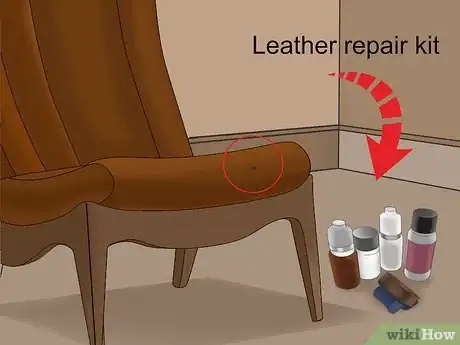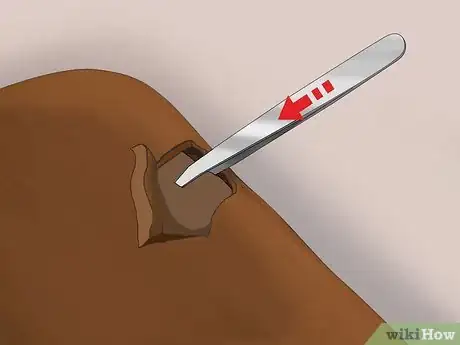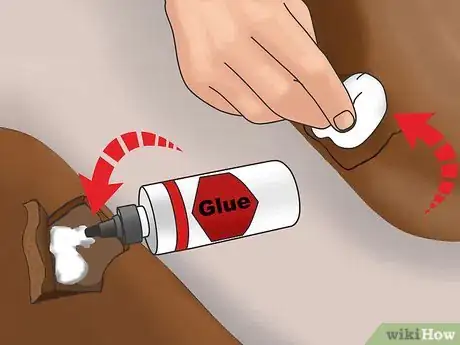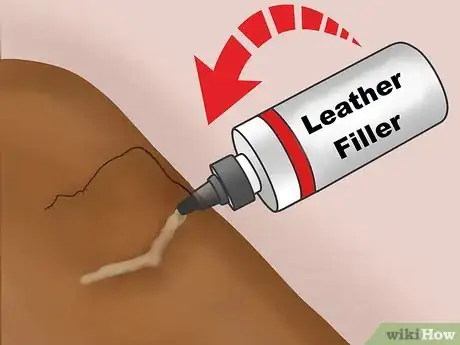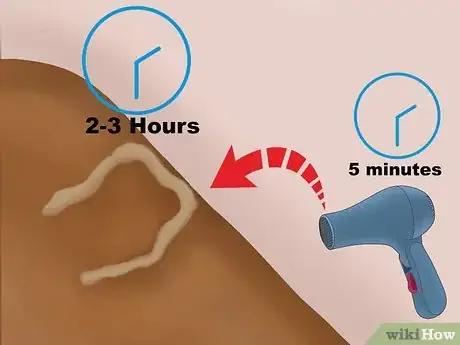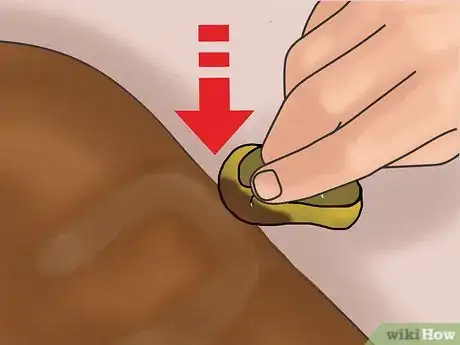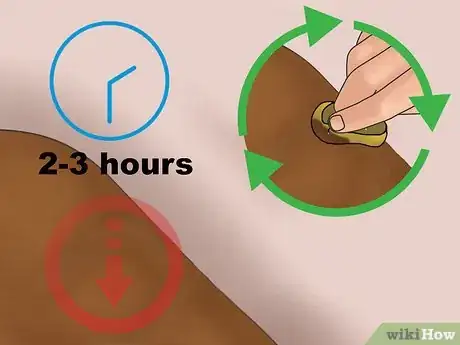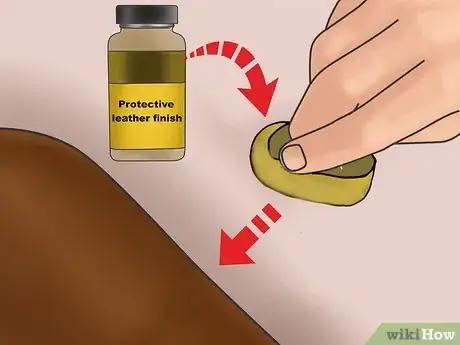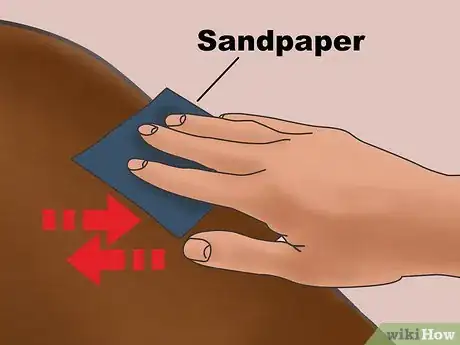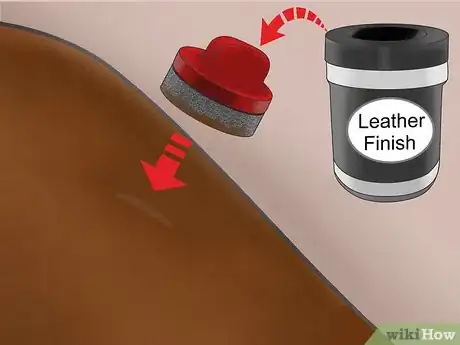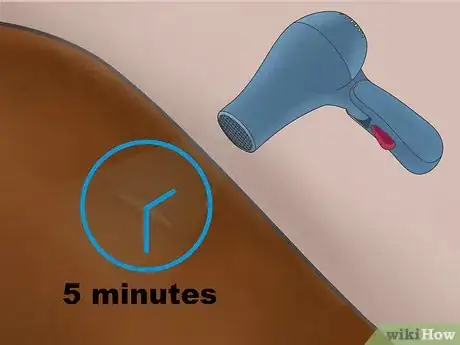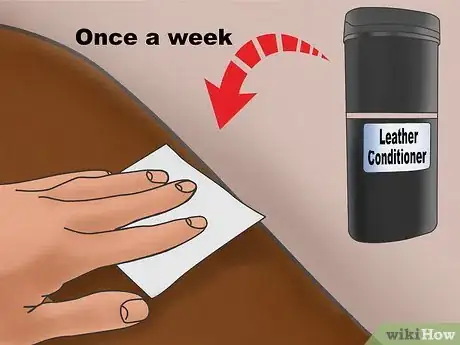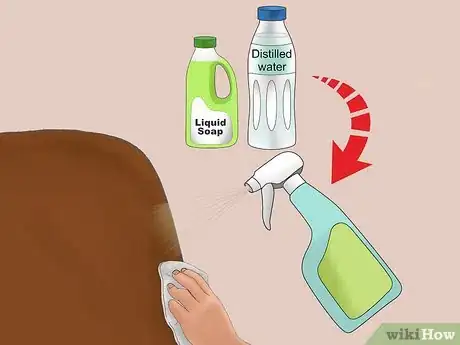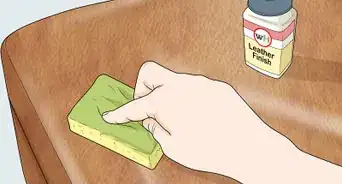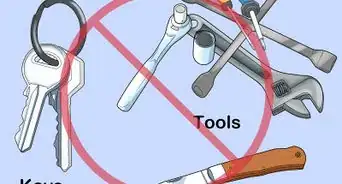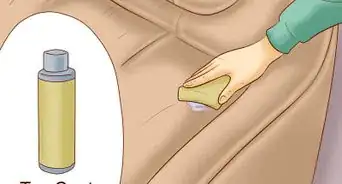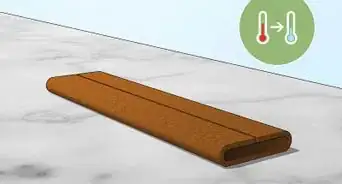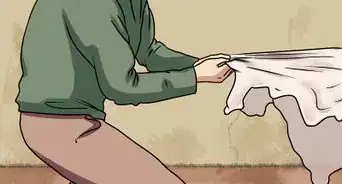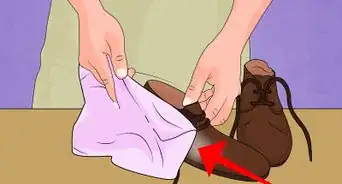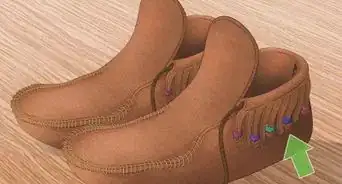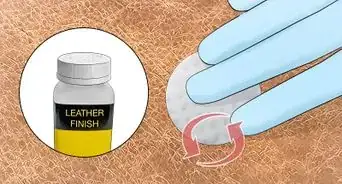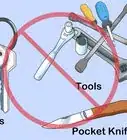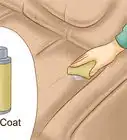This article was co-authored by Mallika Sharma. Mallika Sharma is a Certified Leather Care Technician and the Founder of The Leather Laundry, a niche spa service for luxury leather gear in India. Mallika specializes in leather cleaning, coloring, repairing, and restoring for shoes, handbags, jackets, wallets, belts, and sofas. She holds a Master’s degree in Finance and Investment from the University of Edinburgh Business School. Mallika is a certified Professional Leather Care Technician and trained with the globally reputed leather care company, LTT in the United Kingdom.
There are 9 references cited in this article, which can be found at the bottom of the page.
This article has been viewed 31,570 times.
Leather furniture can be very beautiful in your home, but ripping or tearing a hole in your leather is just so frustrating! If you’ve got a tear in your leather chair, consider purchasing a leather repair kit. Find a kit that matches the color of your chair to fill in the hole and dye it to match the rest of the chair. You can also try gluing the edges together and gently sanding down the adhesive. With either method, you’ll need to add several layers of leather finish at the end of your project. Then, your chair should be looking good as new!
Steps
Using a Leather Repair Kit to Patch Holes
-
1Purchase a leather repair kit in a color to match your chair. This will include some backing, adhesive furniture glue, leather filler, colorant, and leather finisher. Make sure that you choose a kit that corresponds to the color of your leather that needs to be repaired.[1]
- These kinds of kits should be available for purchase from your local furniture store, leather work store, from an online retailer, or maybe even from a shoe store in your area.
- Inspect each available repair kit to identify the variety of colors offered. While it may be impossible to find a perfect match, you should be able to make a visual match by simply looking at the color palettes on the packages.
-
2Insert the repair patch into the hole. Use some tweezers to squeeze the repair patch into the hole in the leather. You’ll need to flatten it out so that the patch is resting just underneath the hole in the leather. It should be positioned completely inside the chair, just under the surface of the hole.[2]Advertisement
-
3Glue the repair patch to the underneath side of the leather rip. Once you have positioned the repair patch inside the hole of the chair, squeeze the tip of a furniture glue bottle into the opening where the leather is torn and apply a thick layer of glue on top of the repair patch. Press down firmly on the repair patch so that it adheres to the leather on top (including the surface of the hole).
- Use a clean rag or cotton swabs to quickly dab up any excess glue that may squeeze out around the sides to ensure a more professional-looking end result.
-
4Apply the leather filler to the hole in the leather. In the gap where the hole is, apply a thin layer of leather filler (thick layers will take too long to dry). The filler itself will either come in a bottle with a pointed nose, or in a small tub. If you have a self-dispensing bottle, simply place the end of the bottle inside the hole and squeeze it as you fill up the hole in the leather, smoothing the surface with a small putty knife when you finish.[3] [4]
- If you have a tub of leather filler, use your putty knife to spoon some of the material out and carefully wipe it into the hole, smoothing out the surface as you go along.
- Make sure to only put a thin layer of leather filler on for each application.
-
5Let each layer of leather filler dry for 2-3 hours. Be sure to allow the leather filler to dry fully between each application, which may take several hours. You can speed the process up significantly by using a hairdryer on a low setting.[5]
- Simply direct the heat from the blow dryer at the filler for up to 5 minutes at a time.
-
6Add additional layers of leather filler. It will take several coats to completely fill in the hole/rip in the leather fabric. Keep applying more layers of leather filler until the filled-in hole becomes level with the surface of the leather.
- It will probably take between 4 and 6 coats to completely fill the rip.
-
7Dab the colorant onto the patch with a sponge. Apply a few drops of the colorant solution to a sponge – enough that the sponge is saturated, but does not drip. Dab it directly onto the section of the leather being repaired, carefully working it onto the existing leather to blend the color together with the filler.[6] [7]
- The colorant is what makes the repair blend in with the rest of leather. The purpose of the colorant is to match the color of the existing leather; you’ll choose the most similar color when you purchase the leather repair kit.
-
8Let the colorant dry for 2-3 hours, then apply it again. It will probably take more than 1 coat of colorant to effectively blend the color to match the surrounding leather. Let each colorant coat fully dry for 2-3 hours before applying the next coat.[8]
- Create a thin coating with each application, as sloppy clumps will not dry correctly. It’s better to do several thin coats than one thick coat.
-
9Apply several coats of leather finish, letting each coat dry in between. Once the colorant has fully dried, it’s time to complete the job with some protective leather finish. This is a product that will protect the surface of your leather, much like a stain finish protects wood products. Using a sponge, apply a small, thin layer at first. Let this coat dry and then repeat the process. It should take about 2 hours for each coat to dry.
- You will probably need 8-10 coats of finish to make sure the repair is in good shape.
Repairing Minor Rips and Tears
-
1Wash the torn area with rubbing alcohol and a clean rag. Dab some rubbing alcohol on a clean rag and gently wipe the surface of your leather chair to clean it before you begin the repair process.
- Be careful not to rub too vigorously or to use more potent cleaning materials as this could discolor your leather or further damage it.
-
2Apply furniture glue to the bottom side of the torn leather. Push the nose of your glue dispenser inside the crack of the ripped leather and apply the glue to the underneath side of the tear on both sides. Make sure to get as little glue as possible on the visible outer surface.[9]
- If the tear is very small, you may need to apply the glue with a cotton swab or toothpick to make sure you can insert it in the ripped area and apply it to the back side of the tear.
-
3Push the ripped sides together. Holding your hands firmly on the leather material, push the 2 ripped edges together so that they are touching and push down against the leather backing. This will connect the 2 sides together and glue them to the leather backing for more support.
- Be sure to wipe up any excess glue with a clean rag or paper towel so that it does not dry in place.
-
4Sand the surface of the leather and the adhesive glue gently. In order to blend the dried glue into the surface of the leather, you’ll need to sand it very gently. Use a 320-grit piece of sandpaper and rub it softly over the surface of the tear.[10]
- You should continue sanding until there is no obvious sign of the adhesive bubbling out from the rip and no cracks in the surface of the leather. Be sure to sand in the direction of the tear (if it’s a rip, not a circular hole).
- Commence the sanding as soon as you glue the pieces together so that the glue doesn’t have time to fully dry. This will help the finished product look more natural, as you’ll have to sand less vigorously than if there were big splotches of hardened glue to sand down.
-
5Dab the first coat of leather finish on with a sponge. Use a sponge or clean rag to apply some leather finish to the repaired rip in the leather. Carefully dip the sponge (or rag) into the top of the leather finish canister until it is covered with a thin layer, but not dripping.[11]
- Dab a thin layer of the leather finish onto the surface of the leather.
-
6Let the leather finish dry completely before moving on. It’s important that you let the first coat of the leather finish dry completely before moving on to the second layer. It will typically take about 2 hours for each layer to dry completely.[12]
- Use a hairdryer on the lowest setting to speed up the drying time. Direct the heat at the surface of the leather for 5 minutes or less at a time.
-
7Apply several layers of leather finish, letting each layer dry in between. You will probably need a half dozen or more layers of leather finish before the repaired portion begins to blend with the rest of the leather chair. Be sure each previous coat is completely dry before starting on the next coat.
- The finish acts as a protective seal for the leather, much like stain on hardwood floors. Applying several layers of finish will help protect the surface of the leather and make your repair last longer.
Conditioning the Leather
-
1Use conditioning wipes once a week to clean and condition the leather. Purchase some leather conditioning wipes from your local home improvement store or from an online retailer. Gently rub the leather surface with the conditioning wipes to help keep the material clean and conditioned.
- You can use them periodically – once a week or so – to maintain the sheen of your leather chair.
-
2Condition with distilled water and liquid soap for a gentle cleaning. To condition and clean the surface of your leather, add a few drops of a pH-neutral non-detergent liquid soap to a spray bottle filled with distilled water. Shake the bottle to ensure proper mixing of the solution. Use a clean microfiber cloth, dampened with the cleaning solution, to gently wipe down the surface of the leather.[13]
- Once you have finished, use a separate microfiber towel to wipe the leather with plain distilled water. This will remove any soapy residue. Then let your leather completely air dry before sitting on it again.
- Using distilled water will ensure that you are not exposing your leather to harmful irritants or allergens that can be present in regular tap water – like trace amounts of heavy metals like iron, copper, magnesium, and zinc, as well as other elements.
-
3Wipe on a mixture of vinegar and linseed oil every few months. For a deep cleaning, wipe your leather chair down with a clean microfiber cloth so that it is clean and free of any dust particles. Combine 1 part white vinegar with 2 parts linseed oil in a spray bottle. Shake the bottle to thoroughly mix the solution. Spray the solution directly onto a small section of the leather, then use a clean rag to work the oil into the surface.[14]
- Move the rag in small, circular motions to really penetrate the surface of the leather. Next, move onto the next area of leather until you’ve finished covering the entire chair.
- Let the solution absorb into the leather surface for 8-10 hours. Then, buff it with a clean microfiber towel.
Expert Q&A
-
QuestionHow do you repair a rip in a leather chair?
 Mallika SharmaMallika Sharma is a Certified Leather Care Technician and the Founder of The Leather Laundry, a niche spa service for luxury leather gear in India. Mallika specializes in leather cleaning, coloring, repairing, and restoring for shoes, handbags, jackets, wallets, belts, and sofas. She holds a Master’s degree in Finance and Investment from the University of Edinburgh Business School. Mallika is a certified Professional Leather Care Technician and trained with the globally reputed leather care company, LTT in the United Kingdom.
Mallika SharmaMallika Sharma is a Certified Leather Care Technician and the Founder of The Leather Laundry, a niche spa service for luxury leather gear in India. Mallika specializes in leather cleaning, coloring, repairing, and restoring for shoes, handbags, jackets, wallets, belts, and sofas. She holds a Master’s degree in Finance and Investment from the University of Edinburgh Business School. Mallika is a certified Professional Leather Care Technician and trained with the globally reputed leather care company, LTT in the United Kingdom.
Certified Leather Care Technician You can fix tears and rips with mending and darning. However, if the leather is completely tattered, you'll need to get it reupholstered.
You can fix tears and rips with mending and darning. However, if the leather is completely tattered, you'll need to get it reupholstered. -
QuestionCan you fix discolored leather?
 Mallika SharmaMallika Sharma is a Certified Leather Care Technician and the Founder of The Leather Laundry, a niche spa service for luxury leather gear in India. Mallika specializes in leather cleaning, coloring, repairing, and restoring for shoes, handbags, jackets, wallets, belts, and sofas. She holds a Master’s degree in Finance and Investment from the University of Edinburgh Business School. Mallika is a certified Professional Leather Care Technician and trained with the globally reputed leather care company, LTT in the United Kingdom.
Mallika SharmaMallika Sharma is a Certified Leather Care Technician and the Founder of The Leather Laundry, a niche spa service for luxury leather gear in India. Mallika specializes in leather cleaning, coloring, repairing, and restoring for shoes, handbags, jackets, wallets, belts, and sofas. She holds a Master’s degree in Finance and Investment from the University of Edinburgh Business School. Mallika is a certified Professional Leather Care Technician and trained with the globally reputed leather care company, LTT in the United Kingdom.
Certified Leather Care Technician No, this isn't a good idea. If your leather is discolored, you'll need to bring it to a professional dry cleaners.
No, this isn't a good idea. If your leather is discolored, you'll need to bring it to a professional dry cleaners. -
QuestionCan you fix a hole or crack in a leather couch?
 Mallika SharmaMallika Sharma is a Certified Leather Care Technician and the Founder of The Leather Laundry, a niche spa service for luxury leather gear in India. Mallika specializes in leather cleaning, coloring, repairing, and restoring for shoes, handbags, jackets, wallets, belts, and sofas. She holds a Master’s degree in Finance and Investment from the University of Edinburgh Business School. Mallika is a certified Professional Leather Care Technician and trained with the globally reputed leather care company, LTT in the United Kingdom.
Mallika SharmaMallika Sharma is a Certified Leather Care Technician and the Founder of The Leather Laundry, a niche spa service for luxury leather gear in India. Mallika specializes in leather cleaning, coloring, repairing, and restoring for shoes, handbags, jackets, wallets, belts, and sofas. She holds a Master’s degree in Finance and Investment from the University of Edinburgh Business School. Mallika is a certified Professional Leather Care Technician and trained with the globally reputed leather care company, LTT in the United Kingdom.
Certified Leather Care Technician Yes, you can fill in holes or cracks with a filler cream. Afterwards, buff the leather out and apply a matching color dye or pigment to the affected area.
Yes, you can fill in holes or cracks with a filler cream. Afterwards, buff the leather out and apply a matching color dye or pigment to the affected area.
Things You’ll Need
- Leather repair kit, including leather colorant
- Leather finish
- Super glue or leather glue
- 320-grit piece of sandpaper
- Leather conditioning wipes
- Vinegar
- Linseed oil
- Non-detergent liquid soap
- Distilled water
- Sponge or clean rag
- Microfiber cloth
- Small putty knife
- Cotton swabs
References
- ↑ https://tombuildsstuff.blogspot.fr/2013/07/do-leather-repair-kits-work.html
- ↑ https://www.colourlock.com/tip/furniture/fluid-leather-repair-holes.html
- ↑ https://www.familyhandyman.com/automotive/car-maintenance/how-to-repair-leather/view-all/
- ↑ Mallika Sharma. Certified Leather Care Technician. Expert Interview. 26 April 2021.
- ↑ https://www.familyhandyman.com/automotive/car-maintenance/how-to-repair-leather/view-all/
- ↑ https://tombuildsstuff.blogspot.fr/2013/07/do-leather-repair-kits-work.html
- ↑ Mallika Sharma. Certified Leather Care Technician. Expert Interview. 26 April 2021.
- ↑ https://tombuildsstuff.blogspot.fr/2013/07/do-leather-repair-kits-work.html
- ↑ https://www.clublexus.com/how-tos/a/lexus-how-to-repair-leather-tears-365764
- ↑ https://www.goldeagle.com/tips-tools/leather-car-seat-repair-how-fix-and-prevent-tears-and-cracks/
- ↑ https://www.youtube.com/watch?v=agpq3wtrM50
- ↑ https://www.youtube.com/watch?v=agpq3wtrM50
- ↑ https://www.forbes.com/sites/houzz/2016/12/13/how-to-clean-and-care-for-leather-furniture/#1fc9f511ff99
- ↑ https://www.apartmenttherapy.com/how-to-condition-leather-furniture-apartment-therapy-tutorials-211838
